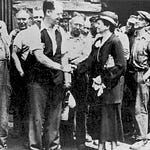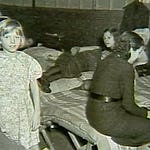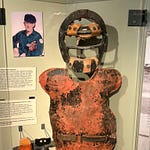This month, at the half-year mark, I’m re-asking quiz questions you’ve already seen. You should nail these! If you’re one of my new subscribers, I welcome you, and don’t be hard on yourself if you don’t get a perfect score. We’re here to have fun!
Ready? Answers are in the footnotes.
QUESTIONS
On February 13, 1861, delegates representing all counties in Virginia met to decide how the state would respond to South Carolina's secession and other events. They voted to remain in the Union and hoped that they could reach a compromise to defuse the situation. Two months later, the same men passed The Virginia Ordinance of Secession, dated April 17, 1861, which declared that “…the bond between Virginia and the United States of America, under the U.S. Constitution, is dissolved.” Delegates at the Virginia Convention of 1861 voted 88–55 to approve the ordinance on April 17 and a statewide referendum confirmed secession on May 23. This meant the northwestern counties needed to act quickly in order to remain part of the Union. What percentage of white men in the northwestern counties voted to stay in the Union?1
52%
67%
75%
Within three days of the vote to remain in the Union, General George B. McClellan’s army occupied the region, notably Wheeling, Morgantown, Parkersburg, and Clarksburg. Pouring oil on troubled waters, McClellan said, “I have ordered troops to cross the river. They come as your friends and brothers (and) as enemies only to the armed rebels who are preying upon you. Your homes, your families, and your property are safe under our protection. All your rights shall be religiously respected,” (which included the right to own slaves). The capital had to be moved from Richmond. Where was the first capital in (what would eventually become) West Virginia?2
Charleston
Morgantown
Parkersburg
Wheeling
Napoleon Bonaparte sold the Louisiana Territory to fund:3
A wedding dowry for his step-daughter Hortense Eugénie Cécile Bonaparte so she could become Queen of Holland by marrying Napoléon’s brother, Louis Bonaparte
A war with the British
Both
Louisville, Kentucky took its name from King Louis XVI of France in appreciation for his help during the Revolutionary War. The city was founded by the brother of either Meriweather Lewis or William Clark, leaders of the Lewis & Clark Expedition of 1804–1806. Was the founder of Louisville a Lewis or a Clark?4
This Pittsburgh native graduated from Pittsburgh Theological Seminary in 1962 and attended Pitt’s Graduate School of Child Development before going on to be a broadcaster in children's television. This TV personality is recognized by more than forty honorary degrees and several awards, including a Lifetime Achievement Emmy in 1997 and the Presidential Medal of Freedom in 2002. Who is this native Pittsburgher?5
This Indiana college was established in 1801 by William Henry Harrison (the ninth U.S. President) while he served as governor of the Indiana Territory. It is now a university. Name that university.6
DePauw University
Valparaiso University
Vincennes University
In 2004, four college students set out to steal several volumes of some of the world’s rarest books from the first educational institution west of the Alleghenies. This institution was established in 1780 by the Commonwealth of Virginia, and its rare books were valued at more than $5.7 million. Name the university.7
Spalding University
Transylvania University
Tusculum University
We talk a lot about the Northwest Territory. What is the importance of the Southwest Territory? Choose as many as apply.8
It’s formal name is the Territory South of the River Ohio, and was created from lands of the Washington District that had been ceded to the U.S. federal government by North Carolina.
The new territory was essentially governed under the same provisions as the Northwest Ordinance, but the Article outlawing slavery was not applied to the Southwest Territory.
Kentucky and Tennessee were carved out of this Territory.
There is a small district of land in the central part of Ohio known as the French Grant because it was settled by French fleeing the Revolution in their home country. Why were French entitled to American land? More than one may apply9
They were descendants of French families who had aided the American Revolution, including the extended family of America’s favorite Frenchman, Lafayette (Marie-Joseph Paul Yves Roch Gilbert du Motier de La Fayette, Marquis de La Fayette).
They had been defrauded by The Scioto Company which had collected some monies from the French without first purchasing the land from the Ohio Company. When the settlers arrived their deeds were worthless. It was five more years before Pres. Washington stepped in and granted them free land in the French Grant, but they had to live on the land for five years in order to own it.
There was a dispute between Michigan and Ohio over who owned the land in the farthest northwest corner of Ohio. When was the dispute finally settled? Fun fact: Those 468 square miles are also called the “Toledo Strip.” ONLY ONE is correct.10
During the War of 1812, but ground survey was not completed until 1817.
In 1836, when the Michigan Territory gave up the “Toledo Strip” and received the large majority of the Upper Peninsula and Michigan.
When Michigan became the 26th State on January 26, 1837.
When the 48th Legislature of Michigan passed Act 84 of the Public Acts of 1915 providing for “a joint re-location and permanent monumenting of the line between Ohio and Michigan”.
In 1915 when the 81st General Assembly of Ohio passed the Michigan Act of 1915 (in answer d) under House Bill 701.
Intermission Message
Podcast recommendations!
First, from Ohio v. The World, a two-part series about the Rise and Fall of Pete Rose.
Second, also from Ohio v. The World, a long episode about “Cancelled Ohioans” that’s well worth extending your drive time to finish. Meet Jimmy the Greek, Arthur St. Clair, Senator and Governor William Allen, Congressman Wayne Hays, and Congressman William Breckenridge. Oh, the scandals!
Third, from The Reckoning, a nine-part series about Kentucky’s history with slavery and how that history connects to issues we face today. Loads of experts and thoughtful topics.
ANSWERS
67%. In some counties, it was 75%. Notably, party allegiance was not a factor in determining how people voted on secession. Fifth Border State (pg 84).
Wheeling would serve as capital for seven years. On March 28,1870, state officials met at the levee in Wheeling to board The Mountain Boy, a steamer laden with state records and other properties, to make the journey down the Ohio River and up the Great Kanawha to the new capital city of Charleston. Source.
Fred Rogers, of course!
Vincennes University
Transylvania University (b). Details of the art heist here. “At the height of its influence, during the first quarter of the 19th century, Transylvania rivaled both Harvard and Yale. It was one of the leading universities in the country in terms of enrollment, faculty, and resources for medical education under the presidency of Horace Holley. Many distinguished men studied at Transylvania including Jefferson Davis, Albert Sidney Johnston, John Hunt Morgan, Stephen Austin, Cassius Clay, John Cabell Breckinridge, and many others.” Source.
Kentucky was not part of the Southwest Territory, but Tennessee was. Therefore, the answer is a and b.
I would have gone for a. but it’s b. I can’t determine whether any of Lafayette’s descendants or extended family settled in the French Grant, but he did receive land grants in Louisiana and Florida. Source. Also, The Sciota Company was a sham operation.
Fun fact: Eight inhabitants of Gallipolis somehow missed out on the 1795 distribution of the French Grant. In 1798 Congress made an additional adjacent grant, called the Second Grant, of 1,200 acres (4.9 km2) for them.
This is a fascinating story, one I never knew before researching this newsletter. I’ll cut to the chase: the correct answer is e (after Ohio passed the bill). I totally made up a, but b, c and d are based in facts (they happened, but didn’t settle the ownership dispute). I don’t have room to explain the whole thing in a footnote. Here’s a terrific page for folks who love nitty-gritty surveyor history.
Basically, the Ohio surveyors were traversing North and East from Ohio’s First Principal Meridian and Baseline while the Michigan surveyors were traversing South and East from the Michigan Meridian and Baseline. After the enforcement of the Pains and Penalties Act by the Michigan Territory, the bloodless Toledo War broke out in 1835. Michigan petitioned for Statehood the same year but they were denied because of the boundary dispute with Ohio. Here’s a page with a timeline on the Toledo Strip.












